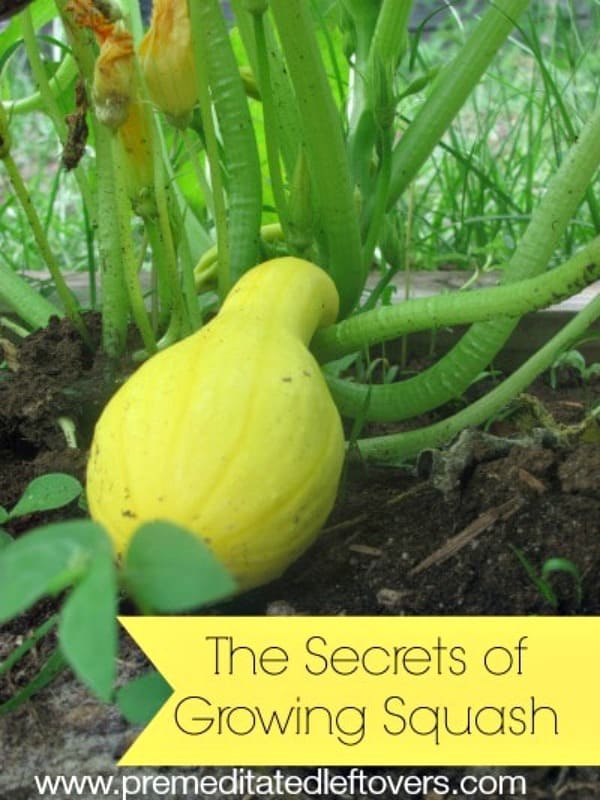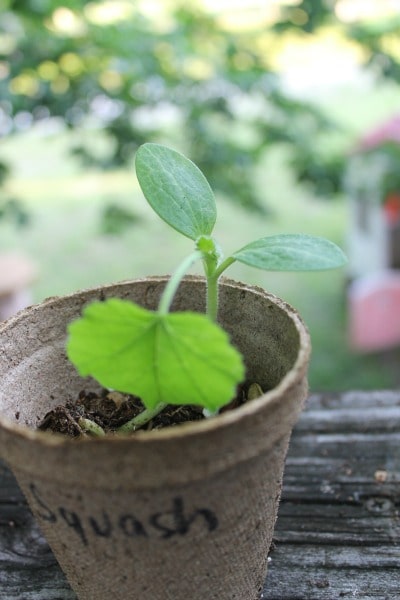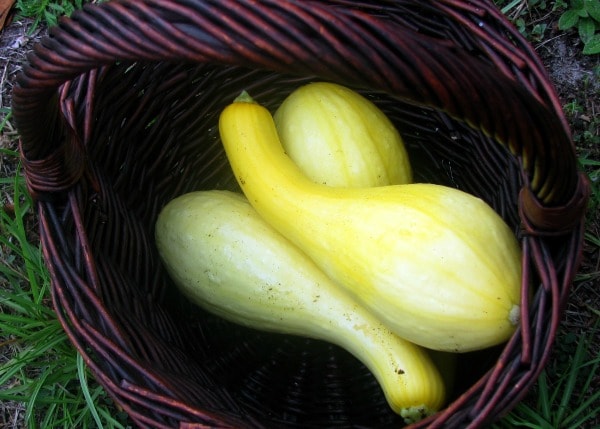Use these tips for growing summer squash in your garden to grow yellow squash and other varieties of summer squash this summer.
Summer squash is one of the most delicious and versatile of the summer crops, whether you grow a variety of yellow squash or zucchini squash. It can be shredded and used in muffins and cakes or sliced, breaded, and fried, baked in casseroles, sautéed on the stove top, grilled, tossed in olive oil and roasted in the oven, chopped up and served fresh with ranch for dipping, and more. Squash flowers are also edible and can be tossed into salads. Summer squash can be grown with little difficulty if you keep a few things in mind. Below I will share my tips for growing summer squash.
Secrets to Growing Summer Squash
Wait to plant squash until there is no longer any chance of frost.
Plant 2-3 seeds in each spot 2′ -3′ apart, about 1″ into the ground. Squash does not like to be transplanted and prefers to be directly planted into the soil. However, if you are eager to get plants started before all frost is past, I have had success planting them in peat pots – just tear away the bottom and plant the pot into the soil.
As your vines (or tendrils) begin to grow you can move them so they follow a certain path, but when they begin to grip don’t mess with them or you can interrupt their growth.
You squash may seem slow growing, but once it begins to flower its growth will take off. Each flower will produce a squash, so take care not to knock off flowers while weeding in your garden or the fruit there will not grow. It can take as little as 7-8 weeks from seed to harvest.
Plant in full sun, in well-drained soil, and be sure to give your plants some organic compost worked into the soil prior to planting. Provide steady moisture to your growing plants, avoid letting them dry out completely. Adding 2″ of mulch around plants will help retain moisture.
Squash is a good candidate for container gardening, just make sure you use a large enough container and keep the soil very moist. A 5-gallon bucket with holes drilled in the bottom is a good candidate for a pot. Spray paint it a pretty color, and it will look wonderful on your porch or deck.
If you want to have squash all season long (right into fall before the first frost), stagger plantings. I usually plant one at the start of spring, end of spring, and mid-summer. Here in the hot temperatures of Florida, I am lucky to have a long growing season.
Harvest young tender fruit when its 7″-8″ long and 2″ in diameter
Most people don’t have a problem with squash bugs, but if you do, here are tips for dealing with squash bugs.
Here are recipes to use up summer squash once your plants start producing.
More Vegetable Growing Tips:
Tips for Growing Heirloom Tomatoes
Tips for Growing Gourmet Lettuces





Stefanie Alldredge says
Do I dig up the plants or do they reproduce the next year? Sorry if it’s a dumb question.
Alea Milham says
They are annuals, so they will die off in the fall. Dig up the dead plants. Then plant new seeds in the spring.
Charise says
Can summer squash grow up a trellis?
Alan H says
I would like to find an organic fungicide formula. In Hawaii, powdery mildew kills the squash plants as they flower and before they can even begin producing, and I want to avoid using synthetic fungicides every week.
Penny Hagedorn says
Can you help me? I live in Yuma, AZ. We have a long growing season. Years ago I had no problem going zucchini but the last couple of years it grows to about 2 inch size then turns yellow and drops off. The plant is beautiful and so are the blooms but the zucchini just doesn’t make it. Thanks
Betty says
I have the same problem. Please can anyone help us?
Lisa Daiboch says
The female (fruit producing) flowers are not being fertilized. We’ve had to hand pollinate at times, super easy! You can do this by either taking a male flower off the plant, and mixing the pollen on the stamens with the female. Or, you can use a q tip, taking pollen from the male first and mixing it with the female flower. Found it best to do first thing in the morning!
Corey says
Do you have any tips for pruning zuccini squash? I’ve had success in harvesting but the vines and leaves tend to get wild and out of hand quickly. I don’t want to cut it up and end up without produce. Thanks
Stenns says
I have two Amazon Zucchini plats that are looming, but the tiny fruit turn yellow and die…what am I doing wrong? Thank you in advance for any response…
HELP please…
Mary C says
Your zucchini flowers are not getting pollinated. You can help them along by hand pollinating in the morning hours.
Stephanie says
Good tips. I will try again next year. I got a few zucchini off my plant this year before it got sick. Only produced the skinny blossoms and had mildew on the leaves. We have had a rainy summer, I wonder if it was just too wet.
alice says
I was wondering if you could help me with a little problem i’m having- my squash plant appears to only be producing female flowers. Do you have any idea why this might be and what i can do about it?
thanks in advance.
Jody says
If you have recently planted it and it was the first showing of flowers, don’t be alarmed. If they continue to drop, it sounds like they are not getting pollinated. For those who don’t know how to distinguish males from females- Males have a single stamen in the center, while females have a 4 part pistil and a large swelling beneath the blossom. If you have a male blossom you can use a q-tip to transfer some of the stamen “dust” to the pistils of your female flower. If you have no males at all on one particular plant you can try pollinating with another or even cross with zucchini flowers. Continue to let it bloom and as soon as you have a male blossom, grab it and help mother nature along.
Rebecca says
Thanks for the great tips! I’m growing squash for the first time this year and just picked my very first squash last week. I sauteed it in a pan with a touch of olive oil, salt and pepper and it was delish! I’m anxiously awaiting the new ones that should be ready to pick in the next few days. I haven’t had any issues with pests on my plants luckily but I have been using a neem oil spray once every few weeks which seems to keep everything looking healthy. It’s done wonders for keeping aphids off my rose bushes!
Jennifer says
Do you know why some of my squash are coming out smooth like you have pictured and some look more like goards? A few of them grew covered in bumpy warts with much darker yellow skin.
Jody says
Are they all the same type? That variety I believe was a yellow crookneck. There are many varieties of summer squash and they can all have different colors and textures as well. Otherwise sometimes this happens when it is left too long on the vine, or certain diseases of the plant can cause lumps and bumps-squash borers, aphids, too much calcium-thee can all cause lumps.
Janet Meenan says
Also if you plant some other type squash nearby it may cross pollinate
jean says
Hey, Jody. I just want to clear up one thing. You state, “Each flower will produce a squash.” This is not true. There is a male and female flower. As you look at the base of the flower you will see a baby squash (female) or there will be just a stem (male). I have been gardening for over 47 years and been living on a farm since I was 2.
Jody says
You are right Jean that was an oversight on my part it should have just read- ” many of these flowers will produce..”
Pam C says
I have problems with the squash borer. It has claimed my squash crops the last 5 years. I want to grow organic, so I am going to try a bunch of different things this year.
Jody says
Hi Pam, Good for you making the decision to go oraganic. While it is a bit more difficult, it is not at all impossible. Here are some things you can try for squash borers-First, as soon as you see eggs, attempt to remove them by hand Try to wrap the base of your stem in aluminum foil to create a barrier against borers. Place a shallow dish of yellow water in the midst of your plants which attracts and traps adults, change out every other day. Remove infested plants as soon as possible to avoid contamination of other squash plants. Use row covers until plants begin to produce. Another way to control garden pests is to let chickens feast in the rows as a natural pest prevention.
Gail Glover Faust says
I HAD TO COVER MY RAISED GARDEN with black plastic from November till spring. It got rid of weeds and bugs as well. I am having the best bug-free garden than I have ever had.
Jeanne says
Gardens alive sells nematodes that eat the grubs in the soil although it has not been tested on them nothing else I have tried works. I am considering raising summer squash in containers so t can change the soil every year